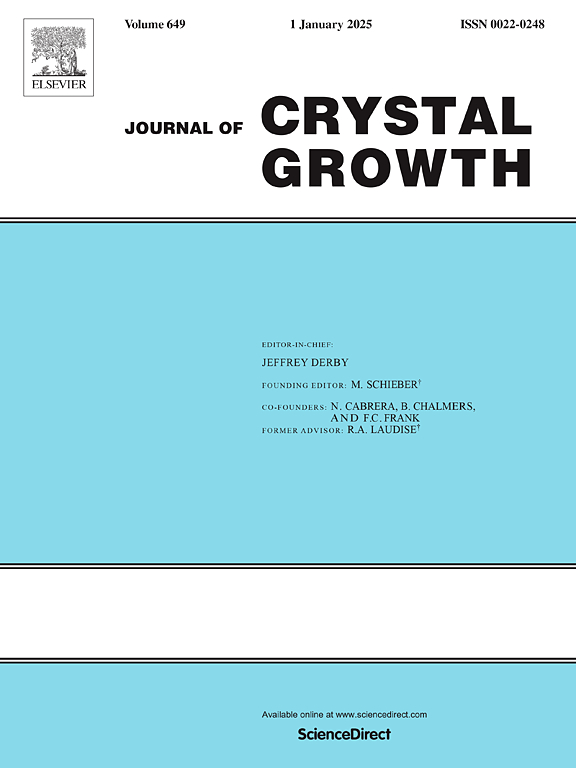Radical enhanced growth of GaN on Si with the buffer layer of GaN at a low temperature of 600 °C
IF 1.7
4区 材料科学
Q3 CRYSTALLOGRAPHY
引用次数: 0
Abstract
Gallium nitride (GaN) films have been grown on Si (111) substrates with low-temperature GaN as a buffer layer using a newly developed Radical Enhanced Metal Organic Chemical Vapor Deposition (REMOCVD) system. This REMOCVD system has three features; (1) the application of very high-frequency (VHF) of 100 MHz to increase the plasma density, (2) the introduction of H2 gas together with N2 gas in the plasma discharge region to generate active NHx radical species in addition to nitrogen radicals, and (3) the radical supply under remote plasma arrangement with suppressed charged ions and photons by employing a Faraday‘s cage. Using this new system, we have studied the homoepitaxial growth of GaN. It was found that high-quality crystals can be grown by REMOCVD at temperatures of 800 °C lower than those of MOCVD. However, the buffer layer is necessary for the heteroepitaxial growth of GaN on Si. In the present study, the low-temperature GaN (LT-GaN) grown at 600 °C was used as the buffer layer. The growth conditions such as the effect of N-termination of Si and the effect of thickness of LT-GaN as a buffer layer were optimized. The surface morphology and the cleaved cross-sectional view of GaN grown on Si substrates were studied by scanning electron microscopy (SEM). The crystal quality of GaN grown on Si substrates was evaluated by X-ray diffraction (XRD). The epitaxial growth of GaN on Si (111) substrates was achieved by the REMOCVD method with a growth rate of approximately 0.6 µm/h at a low temperature of 800 ℃. The present REMOCVD system is a very promising method for the growth of GaN on Si at relatively low temperatures without using toxic and costly ammonia gas.
在600℃低温下,氮化镓的缓冲层自由基增强了氮化镓在硅上的生长
利用新开发的自由基增强金属有机化学气相沉积(REMOCVD)系统在Si(111)衬底上以低温GaN作为缓冲层生长氮化镓(GaN)薄膜。该REMOCVD系统具有三个特点;(1)应用100 MHz甚高频(VHF)提高等离子体密度;(2)在等离子体放电区引入H2气体和N2气体,产生除氮自由基外的活性NHx自由基;(3)利用法拉第笼抑制带电离子和光子在远程等离子体布置下提供自由基。利用这个新系统,我们研究了GaN的同外延生长。结果表明,在比MOCVD低800℃的温度下,REMOCVD可以生长出高质量的晶体。然而,缓冲层对于GaN在Si上的异质外延生长是必需的。本研究采用600℃生长的低温GaN (LT-GaN)作为缓冲层。优化了Si的n端效应和LT-GaN作为缓冲层厚度的影响等生长条件。利用扫描电子显微镜(SEM)研究了生长在硅衬底上的氮化镓的表面形貌和劈裂截面形貌。采用x射线衍射(XRD)对生长在Si衬底上的GaN的晶体质量进行了评价。在800℃低温下,采用REMOCVD方法在Si(111)衬底上实现了GaN的外延生长,生长速率约为0.6 μ m/h。目前的REMOCVD系统是一种非常有前途的方法,可以在相对较低的温度下在Si上生长GaN,而不使用有毒和昂贵的氨气。
本文章由计算机程序翻译,如有差异,请以英文原文为准。
求助全文
约1分钟内获得全文
求助全文
来源期刊

Journal of Crystal Growth
化学-晶体学
CiteScore
3.60
自引率
11.10%
发文量
373
审稿时长
65 days
期刊介绍:
The journal offers a common reference and publication source for workers engaged in research on the experimental and theoretical aspects of crystal growth and its applications, e.g. in devices. Experimental and theoretical contributions are published in the following fields: theory of nucleation and growth, molecular kinetics and transport phenomena, crystallization in viscous media such as polymers and glasses; crystal growth of metals, minerals, semiconductors, superconductors, magnetics, inorganic, organic and biological substances in bulk or as thin films; molecular beam epitaxy, chemical vapor deposition, growth of III-V and II-VI and other semiconductors; characterization of single crystals by physical and chemical methods; apparatus, instrumentation and techniques for crystal growth, and purification methods; multilayer heterostructures and their characterisation with an emphasis on crystal growth and epitaxial aspects of electronic materials. A special feature of the journal is the periodic inclusion of proceedings of symposia and conferences on relevant aspects of crystal growth.
 求助内容:
求助内容: 应助结果提醒方式:
应助结果提醒方式:


